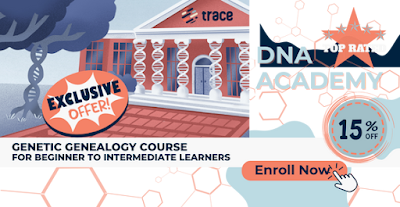Genealogy skills are a superpower. Researching your own family history teaches you how to go back another generation. Sometimes it's a lot of fun to flex your genealogy muscles on someone else's family tree. Inspiration for this type of project can come from anywhere.
In the past, I was inspired by memorials in my grandfathers' hometowns or questions posted in Facebook genealogy groups. TV has played an inspiring role, too.
 |
| Use your genealogy superpower in unexpected ways. I built a celebrity's family tree and discovered he fits into my tree! |
An Old Movie Triggers a Question
I watched a 1952 Dean Martin-Jerry Lewis movie on TCM called "Sailor Beware." I knew James Dean was in one scene, and I spotted him before I had remembered to look for him. But I also noticed one sailor who was in a lot of scenes but may not have said a word. It was actor Vince Edwards in his second-ever movie role. Vince was in a TV show called "Ben Casey" when I was too young to remember watching.
I started to wonder about Vince, with my first thought being, "He looks so Italian. How can his name be Edwards?" So I looked him up and discovered he was the son of Italian immigrants living in Brooklyn, New York. With a little more digging, I found his real last name was Zoino.
Bells went off immediately. I know that name from a couple of Italian towns that were home to my maternal grandmother's ancestors. Today you can find that name in the city of Benevento.
To begin, I went to the 1930 census to find Vince as a two-year-old boy. Then I searched Ancestry records for Vince's father Vincenzo Zoino. I had his birth date and place narrowed down to two men: one from Avellino and one from Benevento. A set of naturalization papers ruled out the man from Avellino.
I went to the Antenati portal to find the right Vincenzo's 1887 birth record from the city of Benevento. With a bit more digging, I found Vince's mother's Benevento birth record, too. Both her parents had last names I've seen often in my own research.
I texted my mom to tell her that "Ben Casey" was our paesan. Not a relative, but a close countryman.
"Finding Your Roots" Strikes a Chord
A couple of years ago an episode of Henry Louis Gates, Jr.'s "Finding Your Roots" featured Tony Danza. The moment the show began, I wondered if his name used to be Iadanza—a name I know from my own research.
Sure enough, Tony Danza's grandfather was Antonio Iadanza. He came from exactly the town I thought he should: Pietrelcina. This town neighbors my great grandmother's town of Pesco Sannita in Benevento.
I went up to my TV and took a photo when they showed Tony's family tree. Now I knew who to search for. I'd already downloaded all the Pietrelcina vital records from the Antenati website. I knew the town had plenty of intermarriage with Pesco Sannita and I'd need those records sooner or later. Having them on my computer made it easier to piece together Tony's ancestors.
I got as far back as two pairs of Tony's 6th great grandparents born in the early 1700s.
 |
| A genealogy hunch became reality with good old-fashioned research. Now this celebrity's family tree fits within mine. |
The fun part of this research is that Tony and his ancestors fit into my family tree. Are Tony and I cousins? No. But his grandmother, Giovanna Zarro, has 22 different connections to my family tree. Each one ties back to my ancestors from neighboring Pesco Sannita.
I think it's fun to have Tony Danza in my family tree. And he could very well share some "Identical By State" DNA with me. (For insight into "Identical By State" DNA, see "This Spreadsheet Sorts DNA Matches By Branch.")
Use Your Superpower for Good
Keep your eyes open for a genealogy challenge that means something to you. Anyone with Benevento or Avellino roots is going to grab my attention.
Does someone have a last name from your family? My Girardi ancestors led me to research Joe Girardi, former manager of the New York Yankees. It turns out his family is from Northern Italy, so there's no relation. I have a 3rd cousin I never met who was a child actor. When he was a regular on a TV show, I saw his last name and had to wonder—is he one of ours? Now I know he is!
Is there someone you admire whose roots make you curious? See what you can learn about them. You may need to find an article to learn their parents' or grandparents' names. Then use the census, ship manifests, draft cards, naturalization papers and more to dig deeper. Prove to yourself how accomplished you are at this genealogy hobby!








